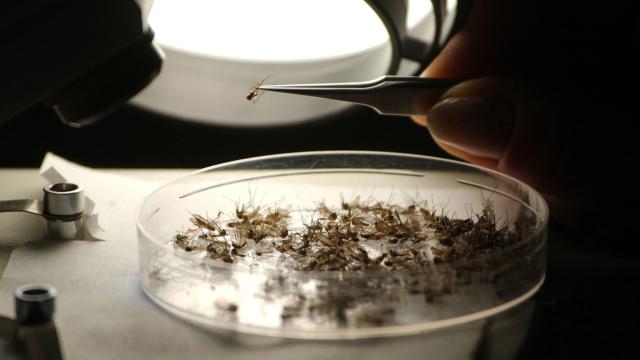Over the weekend, health officials in several U.S. states reported more cases and deaths linked to the Eastern Equine Encephalitis (EEE) virus. The number of cases, while still small, is set to make 2019 the worst recorded year for EEE in recent history — and it may be a sign of things to come in an ever-warming climate.
In Massachusetts, health officials this past Saturday reported the death of a man in his 70s from EEE, the second death and also the 10th human case of EEE seen in the state this year. That same day, officials from Michigan reported that an eighth human case of EEE was spotted within their borders; the state has also seen three deaths linked to EEE.
New Jersey officials also reported the discovery of two more cases among residents, adding to another case found in August, and Connecticut reported its first fatality and second case as well.
In total for 2019, there have been over 25 confirmed or suspected cases of EEE reported across six U.S. states, along with at least seven deaths. It’s not clear yet whether all of these cases represent the most severe form of the virus — an infection that reaches the brain and nervous system that kills a third of its victims. But typically, according to the U.S. Centres for Disease Control, the country sees an average of seven severe EEE cases annually. And this is almost certainly one of the worst years of EEE recorded in decades.
It isn’t just the sheer number of human cases and deaths tied to EEE that makes 2019 such a bad year, according to Theodore Andreadis, director of The Connecticut Agricultural Experiment Station and head of the Centre for Vector Biology & Zoonotic Diseases in Connecticut, but how far the virus seems to have spread throughout the eastern half of the country among people as well as in the birds that naturally carry it.
“Periodically, you know, you might get an outbreak in Massachusetts, Rhode Island, and not necessarily see it in Connecticut and New Jersey. But this year, it’s really all over the entire region,” Andreadis told Gizmodo by phone. “And we don’t even know how many other people might have developed mild sickness or been exposed to the virus and not developed any symptoms. So it’s really rather extraordinary this season.”
EEE isn’t a persistent thorn in our side the way that other diseases spread by mosquitoes, like West Nile virus, are. Human cases are rare because the mosquitoes that can spread it to us live in swampy areas, not cities, and people aren’t part of the virus’ natural life cycle.
But Andreadis and other experts have noted in recent years that the virus is moving into areas where it’s rarely or never been seen before, even as far north as Canada, and individual viral strains are surviving longer.
Climate change isn’t the only reason why this is happening, but it’s definitely part of the picture, according to Andreadis.
“Some of the things that we know about our changing climate in how it’s impacting weather conditions, those certainly do have an impact on mosquito populations,” he said.
Milder winters, for instance, ensure that Northern mosquito populations carrying EEE can live through the season. These survivors then churn more EEE activity in the wild the next year, which can spill over to people.
Warmer summers also tend to boost the populations and feeding activity of mosquitoes, which provide more opportunities for transmission. And the extreme weather events that are becoming more common with climate change — particularly heavy flooding — also create more breeding grounds for mosquitoes carrying EEE, as well as more chances for people living near swampy bodies of freshwater to bump into them.
Again, climate isn’t the only bogeyman here. Increased travel and the encroachment of buildings and homes near areas where these mosquitoes naturally live are factors, too. And it’s possible (though probably not, according to Andreadis) that a strain of EEE more virulent and likely to cause disease in people could have emerged from Florida this year, where the virus lives year-round.
EEE also isn’t likely to be as bad in 2020, if past trends are anything to go by. One reason for this is that birds carrying it in summer will develop immunity, making it less likely to spread the next summer. People also can’t give the virus back to uninfected mosquitoes, limiting its potential spread in a neighbourhood.
But over the long term, it’s almost certain that our warming Earth will make EEE and other bug-spread diseases like West Nile and Lyme a more frequent threat to people. And we don’t exactly have great tools on hand to combat them (there are experimental human vaccines for EEE, but none available to the public, and pesticide spraying rarely reaches the remote places where EEE is concentrated). That’s why it’s crucial for states and researchers to continue tracking the spread of these diseases.
As for people living in the areas where EEE could strike right now, it’s not time to let their guard down — at least not until the first cold frost of the winter shows up. “Mosquito numbers are going down. The virus activity is also going down, but it’s still there in some areas,” Andreadis said.
This continued risk is especially apparent for people eager to camp or hunt near swampy places at dusk or dawn. The best bet to stay safe, Andreadis recommended, is for campers and hunters to hold off for a couple more weeks, and barring that, to wear mosquito repellant at all times.
